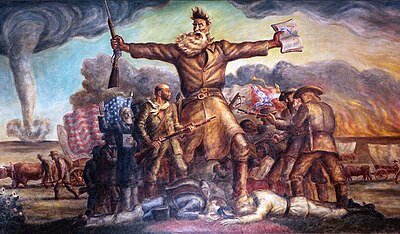
Thomas Hart Benton was an American painter, muralist, and printmaker. Along with Grant Wood and John Steuart Curry, he was at the forefront of the Regionalist art movement. The fluid, sculpted figures in his paintings showed everyday people in scenes of life in the United States.
For many decades, Kansas has had a vibrant country and bluegrass scene. The Country Stampede Music Festival – one of the largest music festivals in the country – and the bluegrass/acoustic Walnut Valley Festival are testament to the continued popularity of these music genres in the state. Among current leading country artists, Martina McBride and Chely Wright are natives of Kansas.
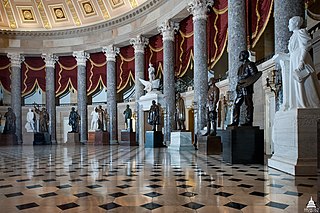
The National Statuary Hall is a chamber in the United States Capitol devoted to sculptures of prominent Americans. The hall, also known as the Old Hall of the House, is a large, two-story, semicircular room with a second story gallery along the curved perimeter. It is located immediately south of the Rotunda. The meeting place of the U.S. House of Representatives for nearly 50 years (1807–1857), after a few years of disuse it was repurposed as a statuary hall in 1864; this is when the National Statuary Hall Collection was established. By 1933, the collection had outgrown this single room, and a number of statues are placed elsewhere within the Capitol.

Bleeding Kansas, Bloody Kansas, or the Border War was a series of violent civil confrontations in Kansas Territory, and to a lesser extent in western Missouri, between 1854 and 1859. It emerged from a political and ideological debate over the legality of slavery in the proposed state of Kansas.
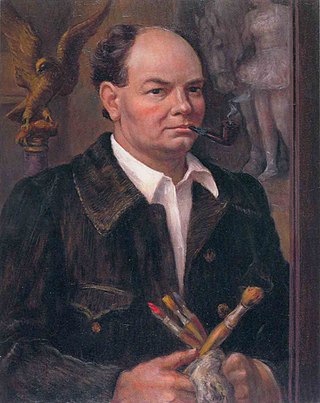
John Steuart Curry was an American painter whose career spanned the years from 1924 until his death. He was noted for his paintings depicting rural life in his home state, Kansas. Along with Thomas Hart Benton and Grant Wood, he was hailed as one of the three great painters of American Regionalism of the first half of the twentieth century. Curry's artistic production was varied, including paintings, book illustrations, prints, and posters.

William Allen White was an American newspaper editor, politician, author, and leader of the Progressive movement. Between 1896 and his death, White became a spokesman for middle America.
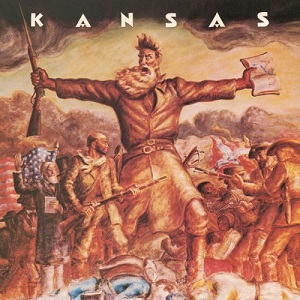
Kansas is the debut studio album by American progressive rock band Kansas, released in 1974 by Kirshner in the United States and Epic Records in other countries.

The Kansas State Capitol, known also as the Kansas Statehouse, is the building housing the executive and legislative branches of government for the U.S. state of Kansas. Located in the city of Topeka, which has served as the capital of Kansas since the territory became a state in 1861, the building is the second to serve as the Kansas Capitol. During the territorial period (1854–1861), an earlier capitol building was begun but not completed in Lecompton, Kansas, and smaller structures in Lecompton and Topeka were where the territorial legislatures met.

American Regionalism is an American realist modern art movement that included paintings, murals, lithographs, and illustrations depicting realistic scenes of rural and small-town America primarily in the Midwest. It arose in the 1930s as a response to the Great Depression, and ended in the 1940s due to the end of World War II and a lack of development within the movement. It reached its height of popularity from 1930 to 1935, as it was widely appreciated for its reassuring images of the American heartland during the Great Depression. Despite major stylistic differences between specific artists, Regionalist art in general was in a relatively conservative and traditionalist style that appealed to popular American sensibilities, while strictly opposing the perceived domination of French art.

The United States Capitol building features a central rotunda below the Capitol dome. Built between 1818 and 1824, the rotunda has been described as the Capitol's "symbolic and physical heart".

Charles Banks Wilson was an American artist. Wilson was born in Springdale, Arkansas in 1918; his family eventually moved to Miami, Oklahoma, where he spent his childhood. A painter, printmaker, teacher, lecturer, historian, magazine and book illustrator, Wilson's work has been shown in over 200 exhibitions in the United States and across the globe.

The following outline is provided as an overview of and topical guide to the U.S. state of Kansas:
Wilber Moore Stilwell (1908–1974) was an American depression era artist, White House/National Gallery of Art/American Artists Professional League honoree, inventor, patent holder, author, and Chair of Art, University of South Dakota.
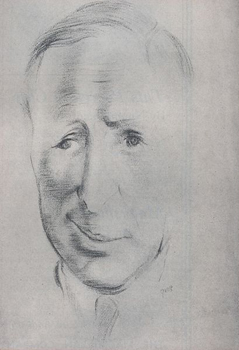
Thomas Craven was an American author, critic and lecturer, who promoted the work of American Regionalist painters, Thomas Hart Benton, John Steuart Curry and Grant Wood, among others. He was known for his caustic comments and being the "leading decrier of the School of Paris."

Dunavant is an unincorporated community in Jefferson County, Kansas, United States.
Achelous and Hercules is a 1947 mural painting by Thomas Hart Benton. It depicts a bluejeans-wearing Hercules wrestling with the horns of a bull, a shape the protean river god Achelous was able to assume. The myth was one of the explanations offered by Greco-Roman mythology for the origin of the cornucopia, a symbol of agricultural abundance. Benton sets the scene during harvest time in the U.S. Midwest.
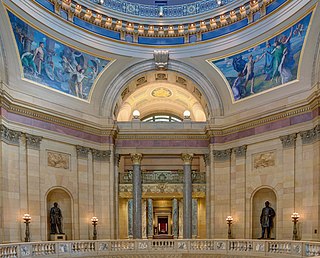
The Minnesota State Capitol opened in 1905 with roughly 60 artworks that totaled $300,000, or 7% of the $4.5-million project budget. Cass Gilbert, the architect of the Capitol building, had envisioned that the artworks would add "educational value" and provide for the "advancement of civilization and intelligence." Over the years, more artworks would be added to the Capitol, totaling nearly 150 by 2017. Much of the Capitol art is allegorical, as expressed through murals and sculptures, while some feature key moments in Minnesota history. While the allegorical symbolism used in the paintings would have been more widely understood during the time they were painted, over time the meanings have been challenged.

Tornado over Kansas, or simply The Tornado, is a 1929 oil-on-canvas painting by the American Regionalist painter John Steuart Curry. It depicts a dramatic scene in which a family races for shelter as a tornado approaches their farm, and has compositional connections to Curry's earlier 1928 painting Baptism in Kansas. The artist is believed to have been influenced by Baroque art and photographs of tornadoes. He developed a fear of natural disasters and a reverence towards God during his childhood, both of which are apparent in the painting.
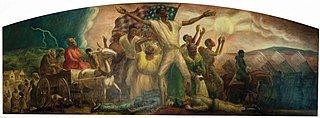
Freeing of the Slaves is an oil and tempera on canvas painting by American artist John Steuart Curry, created in 1942. It is an allegory to the Emancipation Proclamation and the abolition of slavery in the United States, in 1864. It is exhibited at the Law Library's Quarles and Brady Reading Room, in the University of Wisconsin-Madison, in Madison.
